Lyons W.C. (ed.). Standard handbook of petroleum and natural gas engineering.2001- Volume 1
Подождите немного. Документ загружается.


Corrosion and Scaling
1325
Most drillstem failures can be attributed to corrosion. Therefore, the following
discussion will focus on design considerations to minimize drillstem failures. Tool
joints suffer high wear on the outer surface because of the abrasion against
the hole wall. This abrasive effect worsens with an increase in hole deviation.
As
the tool joint rotates under high lateral force against the hole wall, its temperature
rises and may reach lower critical levels. The tool joint is alternatively heated by
friction and quenched by drilling fluid. This leads to formation of small cracks,
leading to hard-facing corrosion fatigue or sulfide stress cracking. Hard-facing the
Tension
due
to
hookloads
4
#
:Tension
r
Torsion
Tension due
to
dril!
collars
Figure
4-478.
Stress loading
on
drillstem.
(From
Ref.
[278].)
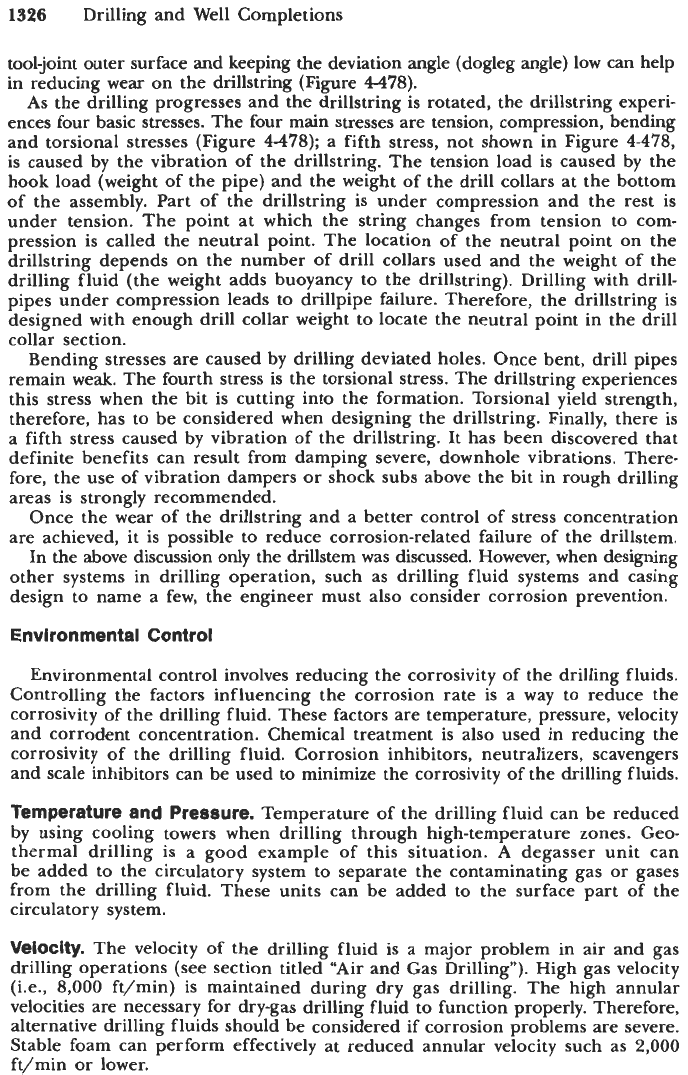
1326
Drilling and Well Completions
tool-joint outer surface and keeping the deviation angle (dogleg angle) low can help
in reducing wear on the drillstring (Figure
4478).
As
the drilling progresses and the drillstring is rotated, the drillstring experi-
ences four basic stresses. The four main stresses are tension, compression, bending
and torsional stresses (Figure
4-478);
a fifth stress, not shown in Figure
4-478,
is caused by the vibration of the drillstring. The tension load is caused by the
hook load (weight of the pipe) and the weight of the drill collars at the bottom
of the assembly. Part of the drillstring is under compression and the rest is
under tension. The point at which the string changes from tension to com-
pression is called the neutral point. The location
of
the neutral point on the
drillstring depends on the number of drill collars used and the weight of the
drilling fluid (the weight adds buoyancy to the drillstring). Drilling with drill-
pipes under compression leads to drillpipe failure. Therefore, the drillstring is
designed with enough drill collar weight to locate the neutral point in the drill
collar section.
Bending stresses are caused by drilling deviated holes. Once bent, drill pipes
remain weak. The fourth stress is the torsional stress. The drillstring experiences
this stress when the bit is cutting into the formation. Torsional yield strength,
therefore, has to be considered when designing the drillstring. Finally, there is
a fifth stress caused by vibration of the drillstring. It has been discovered that
definite benefits can result from damping severe, downhole vibrations. There-
fore, the use of vibration dampers
or
shock subs above the bit in rough drilling
areas is strongly recommended.
Once the wear of the drillstring and a better control of stress concentration
are achieved, it
is
possible to reduce corrosion-related failure
of
the drillstem.
In the above discussion
only
the drillstem
was
discussed. However, when designing
other systems in drilling operation, such as drilling fluid systems and casing
design to name a few, the engineer must also consider corrosion prevention.
Environmental Control
Environmental control involves reducing the corrosivity of the drilling fluids.
Controlling the factors influencing the corrosion rate is a way to reduce the
corrosivity of the drilling fluid. These factors are temperature, pressure, velocity
and corrodent concentration. Chemical treatment
is
also used in reducing the
corrosivity of the drilling fluid. Corrosion inhibitors, neutralizers, scavengers
and scale inhibitors can be used to minimize the corrosivity
of
the drilling fluids.
Temperature and Pressure.
Temperature of the drilling fluid can be reduced
by using cooling towers when drilling through high-temperature zones. Geo-
thermal drilling
is
a good example of this situation.
A
degasser unit can
be added
to
the circulatory system
to
separate the contaminating gas or gases
from the drilling fluid. These units can be added to the surface part of the
circulatory system.
Velocity.
The velocity of the drilling fluid
is
a major problem in air and gas
drilling operations (see section titled “Air and Gas Drilling”). High gas velocity
(i.e.,
8,000
ft/min) is maintained during dry gas drilling. The high annular
velocities are necessary for dry-gas drilling f hid
to
function properly. Therefore,
alternative drilling fluids should be considered if corrosion problems are severe.
Stable foam can perform effectively at reduced annular velocity such as
2,000
ft/min or lower.
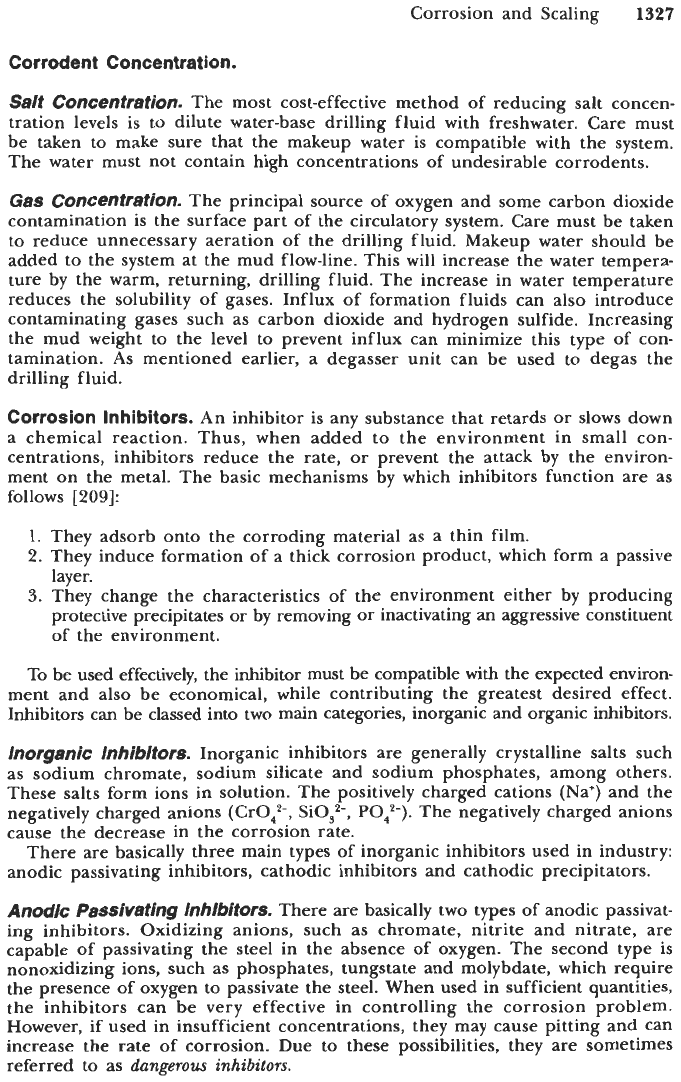
Corrosion and Scaling
1327
Corrodent Concentration.
salt
Concentration.
The most cost-effective method of reducing salt concen-
tration levels is to dilute water-base drilling fluid with freshwater. Care must
be taken to make sure that the makeup water is compatible with the system.
The water must not contain high concentrations of undesirable corrodents.
Gas
Concentration-
The principal source
of
oxygen and some carbon dioxide
contamination is the surface part of the circulatory system. Care must be taken
to reduce unnecessary aeration
of
the drilling fluid. Makeup water should be
added to the system at the mud flow-line. This will increase the water tempera-
ture by the warm, returning, drilling fluid. The increase in water temperature
reduces the solubility of gases. Influx of formation fluids can also introduce
contaminating gases such as carbon dioxide and hydrogen sulfide. Increasing
the mud weight to the level to prevent influx can minimize this type of con-
tamination.
As
mentioned earlier, a degasser unit can be used to degas the
drilling fluid.
Corrosion Inhibitors.
An inhibitor is any substance that retards or slows down
a chemical reaction. Thus, when added to the environment in small con-
centrations, inhibitors reduce the rate, or prevent the attack by the environ-
ment on the metal. The basic mechanisms by which inhibitors function are as
follows
[209]:
1.
They adsorb onto the corroding material as a thin film.
2.
They induce formation of a thick corrosion product, which form a passive
layer.
3.
They change the characteristics of the environment either by producing
protective precipitates or by removing or inactivating an aggressive constituent
of the environment.
To be used effectively, the inhibitor must be compatible with the expected environ-
ment and also be economical, while contributing the greatest desired effect.
Inhibitors can be classed into two main categories, inorganic
and
organic inhibitors.
horganic Inhi6itors.
Inorganic inhibitors are generally crystalline salts such
as sodium chromate, sodium silicate and sodium phosphates, among others.
These salts form ions in solution. The positively charged cations (Na') and the
negatively charged anions (Cr0,2-, SO:-,
PO:-).
The negatively charged anions
cause the decrease in the corrosion rate.
There are basically three main types of inorganic inhibitors used in industry:
anodic passivating inhibitors, cathodic inhibitors and cathodic precipitators.
Anodic
PaSSivatirtg
/nhi6/t0mm
There are basically two types of anodic passivat-
ing inhibitors. Oxidizing anions, such as chromate, nitrite and nitrate, are
capable of passivating the steel in the absence of oxygen. The second type is
nonoxidizing ions, such as phosphates, tungstate and molybdate, which require
the presence of oxygen to passivate the steel. When used in sufficient quantities,
the inhibitors can be
very
effective in controlling the corrosion problem.
However, if used in insufficient concentrations, they may cause pitting and can
increase the rate of corrosion. Due to these possibilities, they are sometimes
referred to as
dangerous inhibitors.
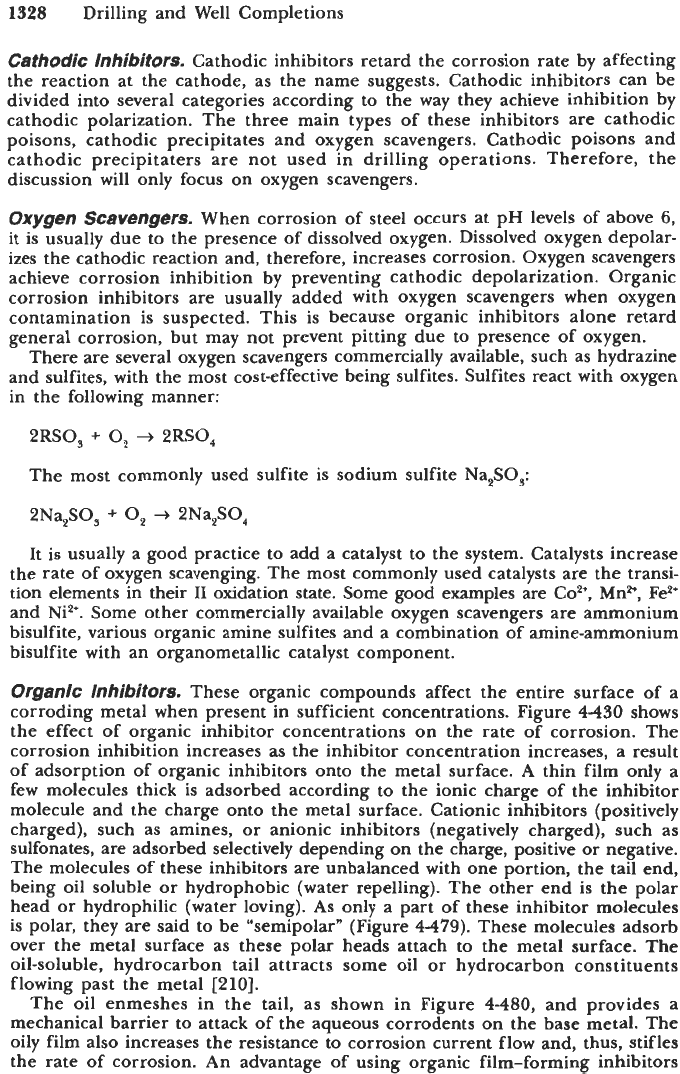
1328
Drilling and Well Completions
Cathodic Inhibitors.
Cathodic inhibitors retard the corrosion rate by affecting
the reaction at the cathode, as the name suggests. Cathodic inhibitors can be
divided into several categories according
to
the way they achieve inhibition by
cathodic polarization. The three main types of these inhibitors
are
cathodic
poisons, cathodic precipitates and oxygen scavengers. Cathodic poisons and
cathodic precipitaters
are
not used in drilling operations. Therefore, the
discussion will only focus on oxygen scavengers.
Oxygen Scavengers.
When corrosion of steel occurs at pH levels of above
6,
it is usually due to the presence of dissolved oxygen. Dissolved oxygen depolar-
izes the cathodic reaction and, therefore, increases corrosion. Oxygen scavengers
achieve corrosion inhibition by preventing cathodic depolarization. Organic
corrosion inhibitors are usually added with oxygen scavengers when oxygen
contamination is suspected. This is because organic inhibitors alone
retard
general corrosion, but may not prevent pitting due to presence of oxygen.
There are several oxygen scavengers commercially available, such as hydrazine
and sulfites, with the most cost-effective being sulfites. Sulfites react with oxygen
in the following manner:
2RS0,
+
0,
+
2RS0,
The most commonly used sulfite is sodium sulfite
N%SO,:
2Na,SO,
+
0,
+
2Na,SO,
It is usually
a
good practice to add a catalyst to the system. Catalysts increase
the rate of oxygen scavenging. The most commonly used catalysts are the transi-
tion elements in their I1 oxidation state. Some good examples
are
eo2+, Mn*, Fe*+
and
Nip.
Some other commercially available oxygen scavengers are ammonium
bisulfite, various organic amine sulfites
and
a
combination of amine-ammonium
bisulfite with an organometallic catalyst component.
Organic
Inhibitors.
These organic compounds affect the entire surface of a
corroding metal when present in sufficient concentrations. Figure
4-430
shows
the effect of organic inhibitor concentrations on the rate of corrosion. The
corrosion inhibition increases
as
the inhibitor concentration increases,
a
result
of adsorption of organic inhibitors onto the metal surface.
A
thin film only
a
few molecules thick is adsorbed according to the ionic charge of the inhibitor
molecule and the charge onto the metal surface. Cationic inhibitors (positively
charged), such as amines, or anionic inhibitors (negatively charged), such as
sulfonates, are adsorbed selectively depending on the charge, positive or negative.
The molecules of these inhibitors are unbalanced with one portion, the tail end,
being oil soluble or hydrophobic (water repelling). The other end is the polar
head or hydrophilic (water loving). As only
a
part of these inhibitor molecules
is polar, they are said to be “semipolar” (Figure
4-479).
These molecules adsorb
over the metal surface as these polar heads attach to
the
metal surface. The
oil-soluble, hydrocarbon tail attracts some
oil
or hydrocarbon constituents
flowing past the metal
[210].
The oil enmeshes in the tail, as shown in Figure
4-480,
and provides a
mechanical barrier to attack of the aqueous corrodents on the base metal. The
oily film also increases the resistance to corrosion current flow and, thus, stifles
the rate
of
corrosion. An advantage of using organic film-forming inhibitors
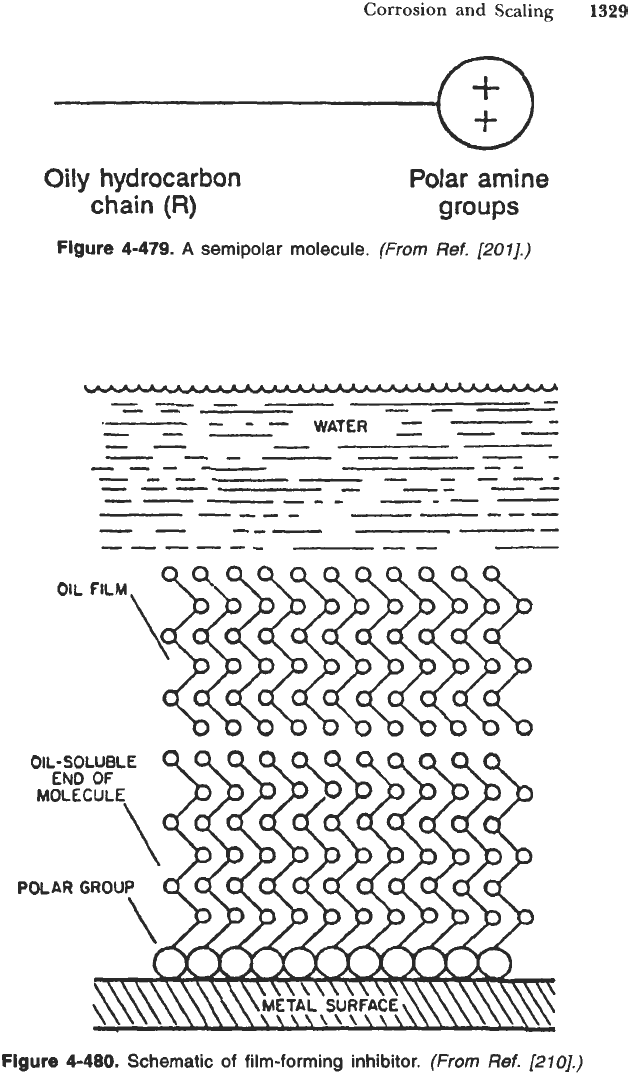
Corrosion and Scaling
1329
Oily
hydrocarbon
chain
(R)
Polar
amine
groups
Figure
4-479.
A
semipolar molecule.
(From
Ref.
[207].)
I-
-
OIL
FILM
Figure
4-480.
Schematic of film-forming inhibitor.
(From
Ref.
[270].)
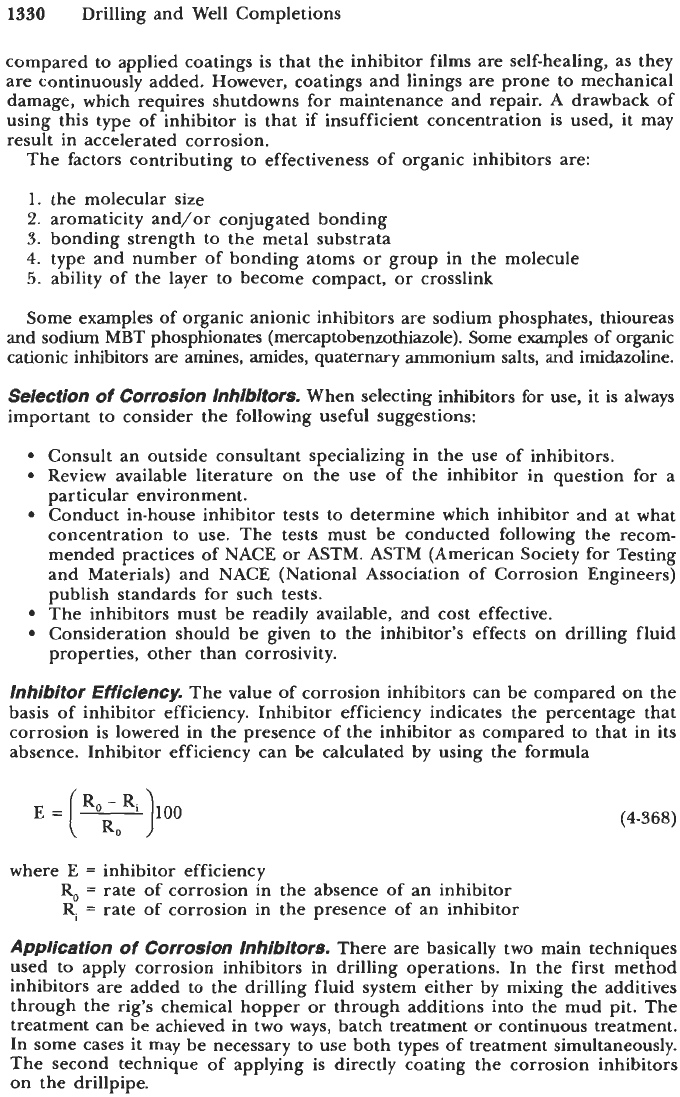
1330
Drilling and Well Completions
compared to applied coatings is that the inhibitor films are self-healing, as they
are continuously added. However, coatings and linings
are
prone to mechanical
damage, which requires shutdowns for maintenance and repair.
A
drawback
of
using this type of inhibitor is that if insufficient concentration is used, it may
result in accelerated corrosion.
The factors contributing
to
effectiveness of organic inhibitors are:
1.
the molecular size
2.
aromaticity and/or conjugated bonding
3.
bonding strength to the metal substrata
4.
type and number of bonding atoms or group in the molecule
5.
ability of the layer to become compact, or crosslink
Some examples of organic anionic inhibitors are sodium phosphates, thioureas
and sodium MBT phosphionates
(mercaptobenzothiazole).
Some examples of organic
cationic inhibitors
are
amines, amides, quaternary ammonium salts, and imidazoline.
Selection
of
Corrosion /nhibitof'$.
When selecting inhibitors for use, it is always
important to consider the following useful suggestions:
Consult an outside consultant specializing in the use of inhibitors.
Review available literature on the use of the inhibitor in question for a
particular environment.
Conduct in-house inhibitor tests to determine which inhibitor and at what
concentration to use. The tests must be conducted following the recom-
mended practices of NACE
or
ASTM. ASTM (American Society for Testing
and Materials) and NACE (National Association of Corrosion Engineers)
publish standards for such tests.
The inhibitors must be readily available, and cost effective.
Consideration should be given to the inhibitor's effects on drilling fluid
properties, other than corrosivity.
inhibitor Efficiency.
The value of corrosion inhibitors can be compared on the
basis of inhibitor efficiency. Inhibitor efficiency indicates the percentage that
corrosion is lowered in the presence
of
the inhibitor as compared to that in its
absence. Inhibitor efficiency can be calculated by using the formula
E
=
(y)lOO
(4-368)
where
E
=
inhibitor efficiency
R,
=
rate of corrosion in the absence of an inhibitor
Ri
=
rate of corrosion in the presence
of
an inhibitor
Application
of
Corrosion inhibitors.
There are basically two main techniques
used to apply corrosion inhibitors in drilling operations. In the first method
inhibitors are added to the drilling fluid system either by mixing the additives
through the rig's chemical hopper
or
through additions into the mud pit. The
treatment can be achieved in two ways, batch treatment
or
continuous treatment.
In some cases it may be necessary to use both types of treatment simultaneously.
The second technique of applying is directly coating the corrosion inhibitors
on the drillpipe.
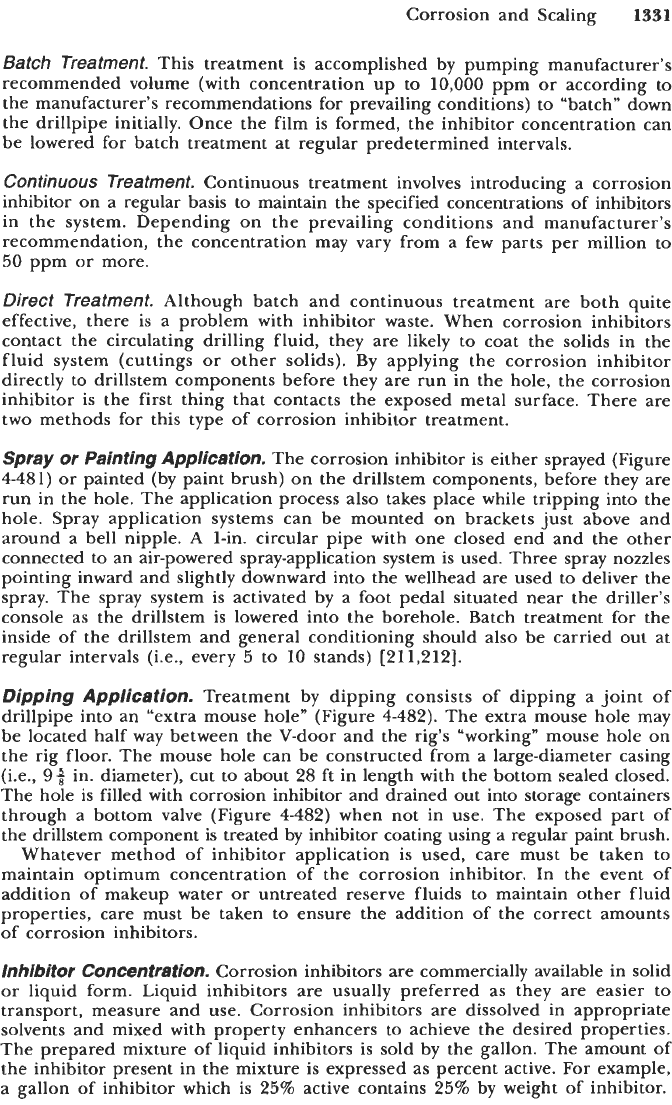
Corrosion and Scaling
1331
Batch
Treatment.
This treatment is accomplished by pumping manufacturer’s
recommended volume (with concentration up
to
10,000
ppm
or
according to
the manufacturer’s recommendations for prevailing conditions) to “batch” down
the drillpipe initially. Once the film is formed, the inhibitor concentration can
be lowered for batch treatment at regular predetermined intervals.
Continuous Treatment.
Continuous treatment involves introducing a corrosion
inhibitor on a regular basis to maintain the specified concentrations of inhibitors
in the system. Depending on the prevailing conditions and manufacturer’s
recommendation, the concentration may vary from a few parts per million to
50
ppm or more.
Direct Treatment.
Although batch and continuous treatment are both quite
effective, there is a problem with inhibitor waste. When corrosion inhibitors
contact the circulating drilling fluid, they are likely to coat the solids in the
fluid system (cuttings
or
other solids). By applying the corrosion inhibitor
directly to drillstem components before they are run in the hole, the corrosion
inhibitor is the first thing that contacts the exposed metal surface. There are
two methods for this type of corrosion inhibitor treatment.
Spray
or
Paintlng Application.
The corrosion inhibitor is either sprayed (Figure
4-481)
or painted (by paint brush) on the drillstem components, before they are
run in the hole. The application process also takes place while tripping into the
hole. Spray application systems can be mounted on brackets just above and
around a bell nipple.
A
1-in. circular pipe with one closed end and the other
connected to an air-powered spray-application system is used. Three spray nozzles
pointing inward and slightly downward into the wellhead are used to deliver the
spray. The spray system is activated by a foot pedal situated near the driller’s
console as the drillstem is lowered into the borehole. Batch treatment for the
inside of the drillstem and general conditioning should also be carried out at
regular intervals (Le., every
5
to
10
stands)
[211,212].
Dipping Application.
Treatment by dipping consists of dipping a joint of
drillpipe into an “extra mouse hole” (Figure
4482).
The extra mouse hole may
be located half way between the V-door and the rig’s “working” mouse hole on
the rig floor. The mouse hole can be constructed from a large-diameter casing
(i.e.,
9$
in. diameter), cut to about
28
ft in length with the bottom sealed closed.
The hole is filled
with
corrosion inhibitor and drained out into storage containers
through a bottom valve (Figure
4-482)
when not in use. The exposed part of
the drillstem component
is
treated by inhibitor coating using
a
regular paint brush.
Whatever method of inhibitor application is used, care must be taken to
maintain optimum concentration of the corrosion inhibitor. In the event of
addition of makeup water or untreated reserve fluids to maintain other fluid
properties, care must be taken to ensure the addition of the correct amounts
of
corrosion inhibitors.
lnbibitor Concentration.
Corrosion inhibitors
are
commercially available in solid
or
liquid form. Liquid inhibitors are usually preferred as they are easier to
transport, measure and use. Corrosion inhibitors are dissolved in appropriate
solvents and mixed with property enhancers to achieve the desired properties.
The prepared mixture
of
liquid inhibitors is sold by the gallon. The amount of
the inhibitor present in the mixture is expressed as percent active.
For
example,
a gallon of inhibitor which is
25%
active contains
25%
by weight of inhibitor.
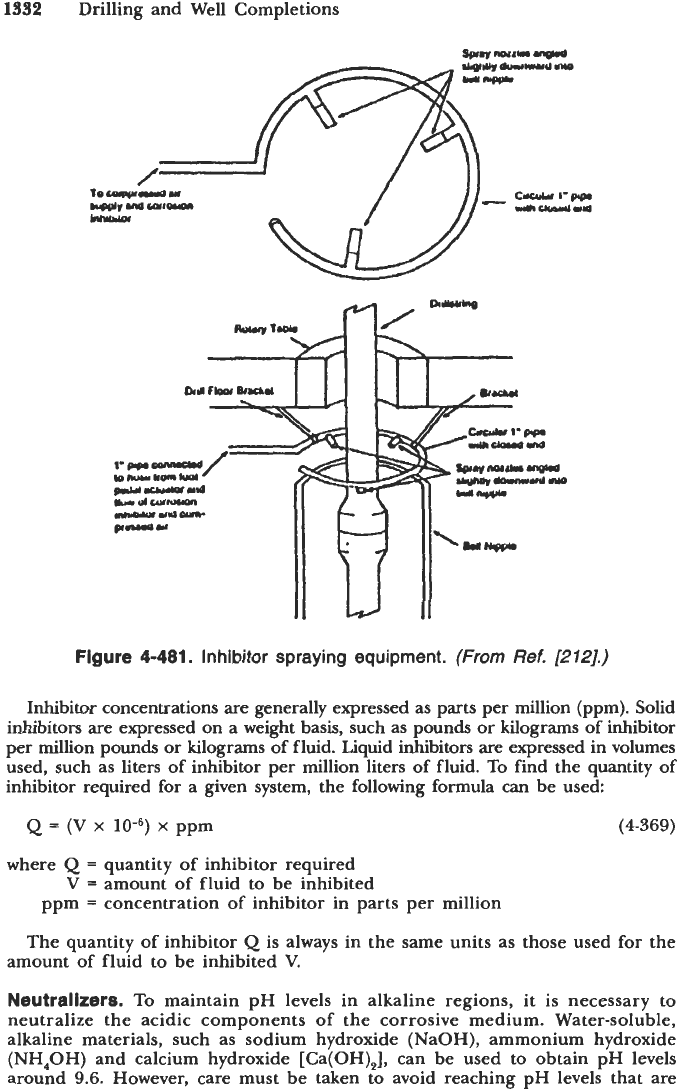
1332
Drilling and Well Completions
Figure
4-481.
Inhibitor spraying equipment.
(From
Ref.
[272].)
Inhibitor concentrations are generally expressed as parts per million (ppm). Solid
inhibitors are expressed on a weight basis, such as pounds or kilograms of inhibitor
per million pounds or kilograms of fluid. Liquid inhibitors are expressed in volumes
used, such as liters of inhibitor per million liters of fluid.
To
find the quantity
of
inhibitor required for a given system, the following formula can be used:
Q
=
(V
x
x
ppm
(4-369)
where
Q
=
quantity of inhibitor required
V
=
amount of fluid to be inhibited
ppm
=
concentration
of
inhibitor in parts per million
The quantity of inhibitor
Q
is always in the same units as those used for the
amount of fluid to be inhibited
V.
Neutralizers.
To
maintain pH levels in alkaline regions, it is necessary to
neutralize the acidic components of the corrosive medium. Water-soluble,
alkaline materials, such as sodium hydroxide (NaOH), ammonium hydroxide
(NH,OH) and calcium hydroxide [Ca(OH),], can be used to obtain pH levels
around
9.6.
However, care must be taken to avoid reaching pH levels that are
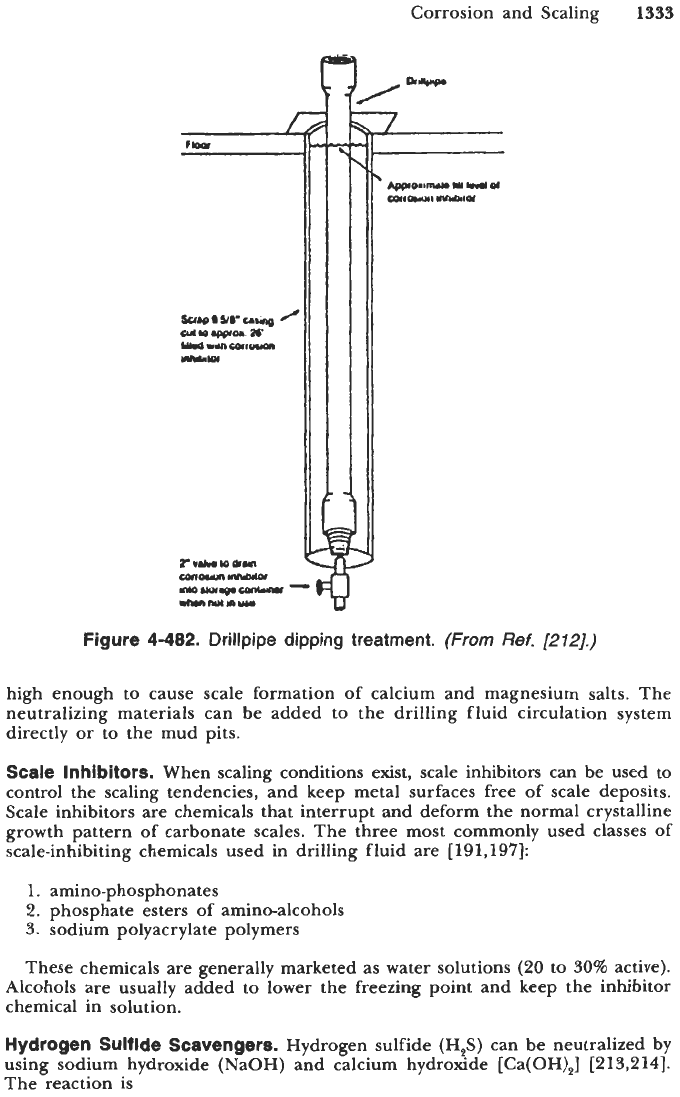
Corrosion and Scaling
1333
Figure
4482.
Drillpipe dipping treatment.
(From
Ref.
[272].)
high enough to cause scale formation of calcium and magnesium salts. The
neutralizing materials can be added to the drilling fluid circulation system
directly or to the mud pits.
Scale Inhibitors.
When scaling conditions
exist,
scale inhibitors
can
be used to
control the scaling tendencies, and keep metal surfaces free of scale deposits.
Scale inhibitors are chemicals that interrupt and deform the normal crystalline
growth pattern of carbonate scales. The three most commonly used classes
of
scale-inhibiting chemicals used in drilling fluid are
[
191,1971:
1.
amino-phosphonates
2.
phosphate esters of amino-alcohols
3.
sodium polyacrylate polymers
These chemicals are generally marketed as water solutions
(20
to
50%
active).
Alcohols are usually added to lower the freezing point and keep the inhibitor
chemical in solution.
Hydrogen Sulfide Scavengers.
Hydrogen sulfide
(H,S)
can be neutralized by
using sodium hydroxide (NaOH) and calcium hydroxide [Ca(OH),]
[213,214].
The reaction is
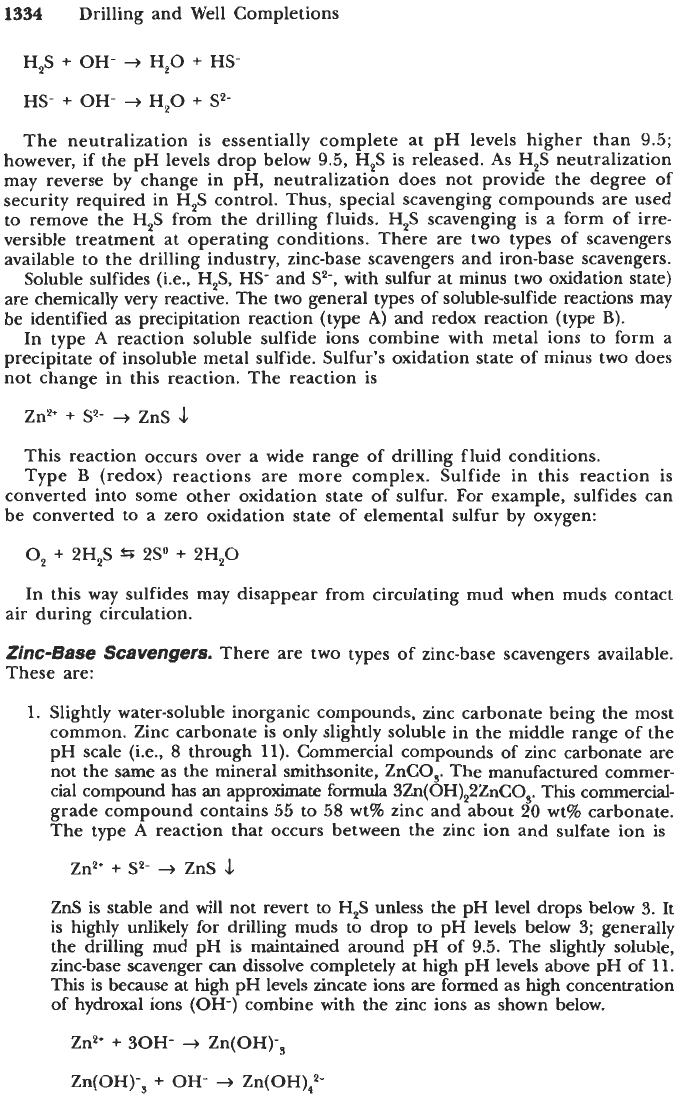
1334
Drilling and Well Completions
H,S
+
OH-
+
H,O
+
HS-
HS-
+
OH-
+-
H,O
+
S2-
The neutralization is essentially complete at pH levels higher than
9.5;
however, if the pH levels drop below
9.5,
H,S is released.
As
H,S neutralization
may reverse by change in pH, neutralization does not provide the degree of
security required in H,S control. Thus, special scavenging compounds are used
to remove the H,S from the drilling fluids. H,S scavenging
is
a form of irre-
versible treatment at operating conditions. There are two types of scavengers
available to the drilling industry, zinc-base scavengers and iron-base scavengers.
Soluble sulfides (Le., H,S, HS- and
Sz-,
with sulfur at minus two oxidation state)
are chemically very reactive. The two general types of soluble-sulfide reactions may
be identified
as
precipitation reaction (type
A)
and redox reaction (type
B).
In type
A
reaction soluble sulfide ions combine with metal ions to form a
precipitate of insoluble metal sulfide. Sulfur's oxidation state of minus two does
not change in this reaction. The reaction is
Zn*
+
~2-
+
ZnS
4
This reaction occurs over a wide range of drilling fluid conditions.
Type
B
(redox) reactions are more complex. Sulfide in this reaction is
converted into some other oxidation state of sulfur.
For
example, sulfides can
be converted to a zero oxidation state of elemental sulfur by oxygen:
0,
+
2H,S
*
2S0
+
2H,O
In this way sulfides may disappear from circulating mud when muds contact
air during circulation.
Zinc-Base
Scavengers.
There are two types of zinc-base scavengers available.
These are:
1.
Slightly water-soluble inorganic compounds, zinc carbonate being the most
common. Zinc carbonate is only slightly soluble in the middle range of the
pH scale (i.e.,
8
through
11).
Commercial compounds of zinc carbonate are
not the same
as
the mineral smithsonite, ZnCO,. The manufactured commer-
cial compound has
an
approximate formula 3Zn(OH)2ZnCO3. This commercial-
grade compound contains
55
to
58
wt% zinc and about
20
wt%
carbonate.
The type
A
reaction that occurs between the zinc ion and sulfate ion
is
Znz+
+
sZ-
+
ZnS
4
ZnS
is stable
and
will not revert to
J3$
unless the pH level drops below
3.
It
is highly unlikely for drilling muds to drop to pH levels below 3; generally
the drilling mud pH
is
maintained around pH of
9.5.
The slightly soluble,
zinc-base scavenger
can
dissolve completely at high pH levels above pH of
11.
This is because at high
pH
levels zincate ions are formed as
high
concentration
of hydroxal ions (OH-) combine with the zinc ions as shown below.
ZnP'
+
SOH-
+
Zn(0H)-,
Zn(0H)-,
+
OH-
4
Zn(OH),4-
